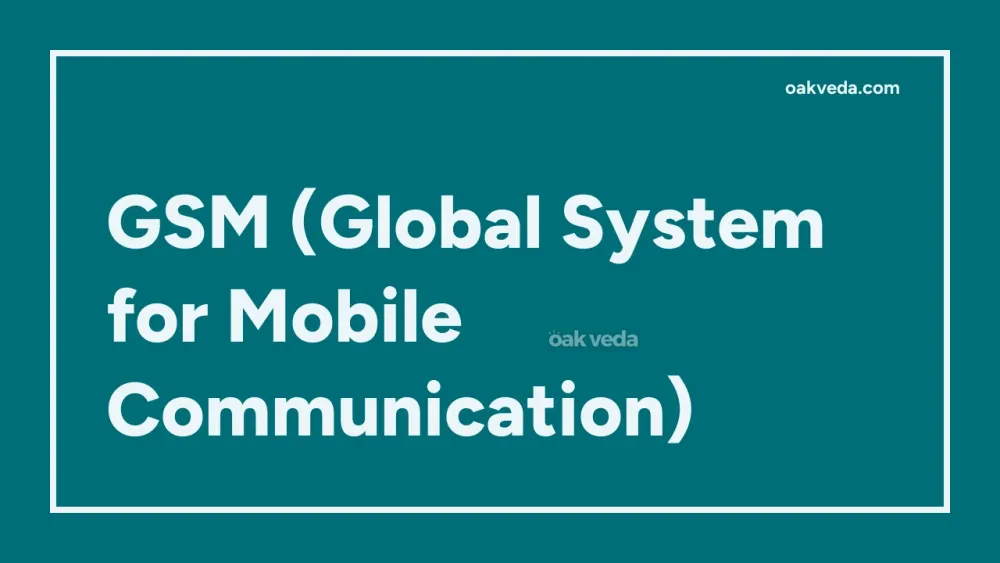
What is the Full Form of GSM?
GSM is the full form of Global System for Mobile Communication. This revolutionary technology has been the backbone of mobile communications for decades, shaping the way we connect and communicate across the globe.
What is Global System for Mobile Communication?
Global System for Mobile Communication, commonly known as GSM, is a digital cellular technology used for transmitting mobile voice and data services. Developed as a replacement for first-generation (1G) analog cellular networks, GSM became the foundation for second-generation (2G) digital cellular systems and has since evolved to support more advanced mobile communications.
Origin and Development of Global System for Mobile Communication
The development of GSM began in the early 1980s when the European Conference of Postal and Telecommunications Administrations (CEPT) formed a group to create a pan-European mobile telephone system. In 1987, the European Telecommunications Standards Institute (ETSI) took over the project, leading to the official launch of GSM services in 1991.
GSM quickly gained popularity due to its improved call quality, enhanced security features, and support for international roaming. This technology set the stage for the mobile revolution, enabling widespread adoption of cellular phones and paving the way for future advancements in mobile communications.
How does Global System for Mobile Communication work?
GSM operates on a cellular network structure, dividing geographical areas into cells. Each cell is served by a base station, which communicates with mobile devices within its coverage area. The system uses a combination of Frequency Division Multiple Access (FDMA) and Time Division Multiple Access (TDMA) techniques to allow multiple users to share the same frequency band.
Key components of the GSM network include:
- Mobile Station (MS): The user's mobile phone or device
- Base Station Subsystem (BSS): Manages radio communications with mobile stations
- Network Switching Subsystem (NSS): Handles call routing and subscriber management
- Operation and Support Subsystem (OSS): Monitors and maintains network operations
Types of Global System for Mobile Communication
While GSM itself is a specific technology, it has evolved to support various frequency bands and generations of mobile networks:
- GSM-900 and GSM-1800: The original European standards
- GSM-850 and GSM-1900: Primarily used in the Americas
- E-GSM (Extended GSM): Provides additional frequency capacity
- R-GSM (Railway GSM): Specialized for railway communications
Functions of Global System for Mobile Communication
GSM serves several crucial functions in mobile telecommunications:
- Voice calls: Enables clear, digital voice communication
- Short Message Service (SMS): Allows text messaging between devices
- Data transmission: Supports basic internet connectivity
- International roaming: Facilitates communication across different countries and networks
- Subscriber identity protection: Enhances security through SIM card technology
Applications of Global System for Mobile Communication
The applications of GSM technology extend beyond personal communication:
- Mobile banking and financial services
- Vehicle tracking and fleet management
- Remote monitoring and control systems
- Emergency services communication
- Machine-to-Machine (M2M) communication
Features of Global System for Mobile Communication
GSM boasts several key features that contributed to its widespread adoption:
- Digital encryption for secure communications
- Efficient use of radio spectrum
- Support for data services, including SMS and GPRS
- SIM card technology for user authentication and portability
- Standardized protocols for international compatibility
Benefits of Global System for Mobile Communication
The adoption of GSM technology brought numerous benefits to users and operators alike:
- Improved voice quality compared to analog systems
- Enhanced security and privacy for users
- Wide-scale adoption leading to cost-effective equipment and services
- Seamless international roaming capabilities
- Foundation for more advanced mobile technologies (3G, 4G, and 5G)
Limitations or Challenges of Global System for Mobile Communication
Despite its success, GSM technology faces some limitations:
- Limited data transmission speeds compared to newer technologies
- Vulnerability to certain types of interception and eavesdropping
- Capacity constraints in densely populated areas
- Interference issues in some environments
- Gradual phasing out in favor of more advanced cellular technologies
Future Developments in Global System for Mobile Communication Technology
While GSM has been largely superseded by newer technologies, its legacy continues to influence mobile communications:
- Integration with 5G networks for improved coverage and capacity
- Enhanced security measures to address evolving cyber threats
- Continued support for IoT and M2M applications
- Gradual transition to more spectrum-efficient technologies
FAQs on GSM Full Form
-
What is the primary difference between GSM and CDMA? GSM uses TDMA technology and SIM cards, while CDMA uses spread-spectrum technology without SIM cards.
-
Is GSM still used today? Yes, GSM is still widely used, especially in areas without advanced 4G or 5G coverage.
-
Can GSM phones work on 4G networks? Most modern phones support multiple technologies, including GSM and 4G, allowing seamless operation across different network types.
-
What replaced GSM technology? 3G, 4G (LTE), and now 5G technologies have largely replaced GSM for high-speed data services.
-
Why was GSM considered more secure than analog systems? GSM introduced digital encryption and SIM card authentication, significantly enhancing security compared to analog systems.
In conclusion, the Global System for Mobile Communication, or GSM, has played a pivotal role in shaping modern telecommunications. While newer technologies continue to emerge, GSM's impact on global connectivity and mobile communication standards remains significant, forming the foundation for our increasingly connected world.
You may be interested in:
- TGT (Trained Graduate Teacher): Full Form and Guide
- EVM (Electronic Voting Machine): Full Form Explained
- MIS (Management Information System) Full Form
- PGDM (Post Graduate Diploma in Management)
- UNESCO (United Nations Educational, Scientific and Cultural Organization)
- BDS (Bachelor of Dental Surgery) Full Form

